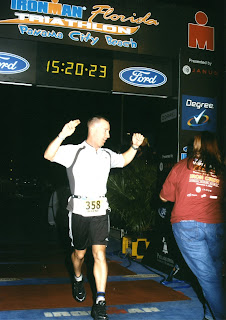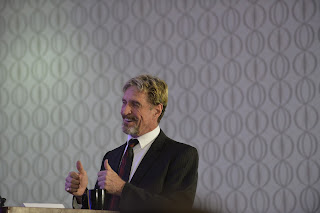 |
| The Author, a decade and many pounds ago....
(Post disclaimer- if I am in the picture, I obviously didn't take it. If I am not in it, I did)
|
And some I could have done better.
I had no idea that the photographer was going to be right around a blind corner, just after the feed bag station on the bike portion of IronMan Florida 2005. So, I came around said blind corner with a PB&J in hand and a mouth full of food. You don't always know where the course photographers will be. That being said, here are some tips:
Look for us near major landmarks on the course. If the race goes past a major landmark, or just a space with a great view or something like a park, an ocean, etc, it's a likely place for photographers to lurk.
Look for us near key race points: If there is a turnaround, lap marker, or other significant point, it's a good spot for us. If the race splits into two courses for say, 5Kvs 10K, half vs full, etc, right before the split is a good place because we can get everyone before you separate.
We will usually be wearing some sort of bright colored clothing, if not a reflective vest. You may notice this before the massive array of camera gear. If you see a reflective vest in the middle of the road up ahead, it's probably attached to a photographer.
Course photographers- make it easy on your athletes..... find a spot where you will be obvious with enough warning for them to see you and prepare for the shot before you need to take it. If the race lets you, put up a sign saying "Photo Zone" or the something like that.)
That covers the mid course, where the photographer could be lurking anywhere. Now we get to the critical time- the FINISH LINE. No matter what happened on the course, unless your race is covered by total idiots or something goes wrong, there WILL be a photographer waiting for you at the finish line. Often several of us covering from different angles. You know we will be there. So be ready. In the shot above, I knew the finish line pic was coming, I put my arms up... then got distracted by the person who finished in front of me being loaded on to a gurney by paramedics. Damn it. Things do happen, but control what you can.
So let's talk about how to make that happen, and my personal pet peeve. Every race I have shot so far, a significant portion of the images come out like these:
Yup. Stopping the digital device. Or sometimes ( I will withhold images for this one to protect the guilty) apparently stopping at the finish line to tweet about finishing the race. Come on. First of all, if you haven't noticed, there is a giant LCD clock running right over your head, showing your time. Second, those mats you just stepped over... yeah, they are connected to a chip that records your exact individual time so you can look it up later. So, waiting an extra five seconds to turn your stopwatch off after you go through the finish shoot really won't kill you. Maybe you can plan for this and turn it on five seconds after you cross the starting line, if it's so important to you, that way it will even out and you will get a good finish line picture.
While the ability to leap like this at the finish probably means you didn't race all out and could have gone harder, it's the energy we like to see at the finish. However; there is one problem that will make it difficult for this superstar to find his picture. Can you see his race number? Neither could I. Which means, as epic as this leap is, it will wind up in the "miscellaneous/lost images" bin on the web site. To make sure you actually are able to find your images later on, you need to make sure that your race number is somewhere on the front of your body, easily visible and, if you can manage it, opened toward the camera and not obscured by your arms, jackets tied around your waist, etc.
On this same note, if your time isn't that important, try to set up your finish so you aren't in a large group of runners, or even in a small group. When that happens, we will desperately try to get shots of as many of the group as we can, but we only can do so much, and if you in the back of the group on the opposite side from the photographer, you may be out of luck. If you have done the run with a group and want to get a group finish shot, line up side by side (as much as you can without blocking other runners behind you who may care about their times) and finish together. Even better if you hold hands. And make it obvious well before the finish line. We're set up to shoot individuals, for a group we'll probably have to flip the camera orientation and open the lens up a bit, which may not be easy since we're probably on a monopod. (try hand holding a pro camera with a 70-200/2.8 zoom for a few hours straight and you won't blame us)
ASIDE: This may seem a bit stereotypical, but I have noticed a distinct difference between groups of male and female runners. There are some exceptions, but for the most part, guys are hypercompetitive assholes who will run a friendly race with someone and supporting each other for 26 miles, will usually then do their best to leave that supportive friend in the dust in the last tenth to finish first. Women who have run a friendly race supporting each other much of the course tend to stick together and finish together.
Another tip- timing is everything. This woman wasn't quite under the finish arch yet, but was celebrating so hard I had to take the shot where she was. There was no one close to her, so I was able to get the shot and am very glad I did. But in general, we are going to take the shot right as close as possible to the moment you actually cross the finish line. If you are crossing by your self, we're gonna shoot right as you cross. If you are in a group, we'll do the best we can to get everyone as close to that moment as we can while still getting shots of everyone who isn't hidden from us behind another runner.
The one exception I make is for bouncing pony tails. I think the shots look better if you can see the hair flying out, so if I have the time I will shoot either early or late if I need to in order to try and get the hair. This really will only make the difference of a step or two, but it's there.
Give us a little emotion. You just ran hard. Even if you didn't win, you were out there. You finished. You rocked it. Enjoy it. Here's a few more people who did it right:
Finally, you really may not care about your race images. You did it for the experience. I admire that. But I hope you will take time to find and purchase your race pics anyway. From a purely selfish point of view, I want you to buy the pics I took because the companies that hire us to shoot notice whose pics get purchased and whose don't. They take that into account when choosing which photographers to hire over and over again for races. All of us photographers like to get paid for what we do, even though we love it. But also do it for yourself. One day, a decade or so from now, you may wind up going through your old photo albums and discover: Holy crap... I really used to be in shape.... I did something awesome... I was a bad ass... hey kids, take a look at what dad /mom did when I was your age.... When I was prepping for this post, I remembered my racing days, but hadn't looked through all the old pics in quite some time. It brought back a lot of memories... and reminded me just how out of shape I have gotten, but I am sure glad I still have all those old shots, it's nice to have proof I used to be skinny. Now, if you will excuse me... I think I need to go for a run.

































